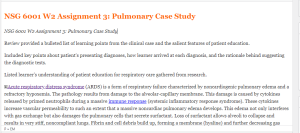NSG 6001 W2 Assignment 3: Pulmonary Case Study
NSG 6001 W2 Assignment 3 Pulmonary Case Study
Review provided a bulleted list of learning points from the clinical case and the salient features of patient education.
Included key points about patient’s presenting diagnoses, how learner arrived at each diagnosis, and the rationale behind suggesting the diagnostic tests.
Listed learner’s understanding of patient education for respiratory care gathered from research.
Acute respiratory distress syndrome (ARDS) is a form of respiratory failure characterized by noncardiogenic pulmonary edema and a refractory hypoxemia. The pathology results from damage to the alveolar-capillary membrane. This damage is caused by cytokines released by primed neutrophils during a massive immune response (systemic inflammatory response syndrome). These cytokines increase vascular permeability to such an extent that a massive noncardiac pulmonary edema develops. This edema not only interferes with gas exchange but also damages the pulmonary cells that secrete surfactant. Loss of surfactant allows alveoli to collapse and results in very stiff, noncompliant lungs. Fibrin and cell debris build up, forming a membrane (hyaline) and further decreasing gas exchange. The combined edema, loss of surfactant, alveoli collapse, and hyaline membrane formation lead to a progressive refractory hypoxemia and eventually death.
Even with outstanding care, the mortality rate for ARDS is 40% to 60%, and even those who survive may have permanent lung damage. With such a high mortality rate, it is clear that early detection and prevention are critical as is treatment of any causal factors. Thus careful assessment of all at-risk individuals for early warning signs of developing respiratory distress is a nursing responsibility. Unfortunately, the only early warning sign may be labored breathing and tachypnea. Once ARDS develops, nursing care focuses on maintenance of pulmonary functions. Despite evidence that ARDS is the result of an inflammatory response, anti-inflammatory therapy is not effective, and with time, respiratory failure with severe respiratory distress usually results. Research is focused on identifying new pharmacological treatments to halt the progressive downward cycle of ARDS, including human recombinant interleukin-1 receptor antagonist surfactant replacement therapy, corticosteroids, and the like.
Grading Rubric
| Performance Category | 100% or highest level of performance
100% 16 points |
Very good or high level of performance
88% 14 points |
Acceptable level of performance
81% 13 points |
Inadequate demonstration of expectations
68% 11 points |
Deficient level of performance
56% 9 points
|
Failing level
of performance 55% or less 0 points |
| Total Points Possible= 50 | 16 Points | 14 Points | 13 Points | 11 Points | 9 Points | 0 Points |
| Scholarliness
Demonstrates achievement of scholarly inquiry for professional and academic topics. |
Presentation of information was exceptional and included all of the following elements:
|
Presentation of information was good, but was superficial in places and included all of the following elements:
|
Presentation of information was minimally demonstrated in all of the following elements:
|
Presentation of information is unsatisfactory in one of the following elements:
|
Presentation of information is unsatisfactory in two of the following elements:
|
Presentation of information is unsatisfactory in three or more of the following elements
|
| 16 Points | 14 Points | 13 Points | 11 Points | 9 Points | 0 Points | |
| Application of Course Knowledge
Demonstrate the ability to analyze and apply principles, knowledge and information learned in the outside readings and relate them to real-life professional situations |
Presentation of information was exceptional and included all of the following elements:
|
Presentation of information was good, but was superficial in places and included all of the following elements:
|
Presentation of information was minimally demonstrated in the all of the following elements:
|
Presentation of information is unsatisfactory in one of the following elements:
|
Presentation of information is unsatisfactory in two of the following elements:
|
Presentation of information is unsatisfactory in three of the following elements
|
| 10 Points | 9 Points | 6 Points | 0 Points | |||
| Interactive Dialogue
Initial post should be a minimum of 300 words (references do not count toward word count) The peer and instructor responses must be a minimum of 150 words each (references do not count toward word count) Responses are substantive and relate to the topic. |
Demonstrated all of the following:
|
Demonstrated 3 of the following:
|
Demonstrated 2 of the following:
|
Demonstrated 1 or less of the following:
|
||
| 8 Points | 7 Points | 6 Points | 5 Points | 4 Points | 0 Points | |
| Grammar, Syntax, APA
Points deducted for improper grammar, syntax and APA style of writing. The source of information is the APA Manual 6th Edition Error is defined to be a unique APA error. Same type of error is only counted as one error. |
The following was present:
AND
AND
|
The following was present:
AND/OR
AND/OR
|
The following was present:
AND/OR
AND/OR
|
The following was present:
AND/OR
AND/OR
|
The following was present:
AND/OR
AND/OR
AND/OR
|
The following was present:
AND/OR
AND/OR
|
| 0 Points Deducted | 5 Points Lost | |||||
| Participation
Requirements |
Demonstrated the following:
|
Failed to demonstrate the following:
|
||||
| 0 Points Lost | 5 Points Lost | |||||
| Due Date Requirements | Demonstrated all of the following:
A minimum of one peer and one instructor responses are to be posted within the course no later than Sunday, 11:59 pm MT. |
Demonstrates one or less of the following.
A minimum of one peer and one instructor responses are to be posted within the course no later than Sunday, 11:59 pm MT. |

